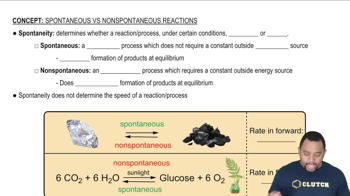Here are the essential concepts you must grasp in order to answer the question correctly.
Entropy (ΔS)
Entropy is a measure of the disorder or randomness in a system. In thermodynamics, a positive change in entropy (ΔS > 0) indicates an increase in disorder, while a negative change (ΔS < 0) suggests a decrease in disorder. For an ideal gas, increasing pressure typically leads to a decrease in volume, which can affect the entropy of the system.
Recommended video:
Entropy in Thermodynamics
Isothermal Process
An isothermal process occurs at a constant temperature, meaning that any heat added to the system is used to do work rather than change the internal energy. For an ideal gas undergoing an isothermal compression or expansion, the relationship between pressure, volume, and temperature is described by the ideal gas law, and the entropy change can be calculated using specific formulas that account for these conditions.
Recommended video:
Entropy Change Calculation
The entropy change (ΔS) for an ideal gas can be calculated using the formula ΔS = nR ln(P2/P1), where n is the number of moles, R is the ideal gas constant, and P2 and P1 are the final and initial pressures, respectively. While the temperature remains constant in this scenario, it is essential to know the temperature to use the ideal gas law and to understand the context of the entropy change, as it influences the absolute values of entropy.
Recommended video:
 Verified step by step guidance
Verified step by step guidance


